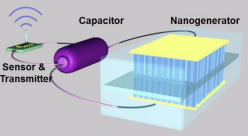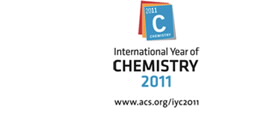FOR IMMEDIATE RELEASE | June 29, 2011
American Chemical Society Podcast: Tiny generator powers wireless device
WASHINGTON, June 29, 2011 — Imagine a new genre of tiny implantable sensors, airborne and stationary surveillance cameras and sensors and other devices that operate without batteries on energy collected from the motion of a heart beat and have wireless communications capability. And the power plant for those devices is a “nanogenerator” that could even produce energy to charge an iPod from the movements of a person walking down the street.
That’s the topic of a new episode in the American Chemical Society’s (ACS) award-winning “Global Challenges/Chemistry Solutions” podcast series, which was released today. The podcast features Zhong Lin Wang, Ph.D., of the Georgia Institute of Technology who, described development of the first practical iteration of the device. Wang and colleagues boosted the power output of earlier devices by thousands of times and its voltage by 150 times. Wang reported on the achievement at an ACS National Meeting held in March in Anaheim, Calif.
Media Contact
Michael Bernstein
202-872-6042
m_bernstein@acs.org
Michael Woods
202-872-6293
m_woods@acs.org
And the news gets even better. In a development just reported in the ACS journal Nano Letters, Wang and his colleagues also showed for the first time that they could integrate such a nanogenerator into an electronic circuit. It can transmit data wirelessly to an ordinary commercial radio at distances up to 30 feet. The generator can produce electricity using energy from a gentle breeze, movements of a person walking and other sources to power those wireless data transmissions.
“This development represents a milestone toward producing portable electronics that can be powered by body movements without the use of batteries or electrical outlets,” Wang says in the podcast. “Our nanogenerators are poised to change lives in the future. Their potential is only limited by one’s imagination.”
The nanogenerator may find a broad range of other applications that require more power, according to Wang. He lists, for example, personal electronic devices powered by footsteps activating nanogenerators inside the sole of a shoe; implanted insulin pumps powered by a heartbeat; and environmental sensors powered by nanogenerators flapping in the breeze.
The new podcast is available without charge at iTunes and from ACS’ website at www.acs.org/globalchallenges.
Global Challenges/Chemistry Solutions is a series of podcasts describing some of the 21st Century’s most daunting problems, and how cutting-edge research in chemistry matters in the quest for solutions. Global Challenges is the centerpiece in an alliance on sustainability between ACS and the Royal Society of Chemistry. Global Challenges is a sweeping panorama of global challenges that includes dilemmas such as providing a hungry, thirsty world with ample supplies of safe food and clean water; developing alternatives to petroleum to fuel society; preserving the environment and assuring a sustainable future for our children; and improving human health. During the 2011 global celebration of the International Year of Chemistry (IYC), Global Challenges/Chemistry Solutions also is focusing on the main themes of IYC — health, environment, energy, and materials.
###

wireless transmission in an advance toward a
new genre of wireless devices.


